| enter keyword to search: |
|
Images db
|
|
|
Articles db
|
|
|
|
|
|
|
|
|
Constructed on a remarkable scale with the west orientation typical of funerary monuments, the temple was the mausoleum of king Suryavarman II (xii c.) and dedicated to the Hindu god Vishnu.
Angkor Wat is a stylistic homogeneous monument, the central complex is a quincunx of towers within three enclosures laying on different levels and surrounded by a vast expanse enclosed by a fourth outermost enclosure wall and a water filled moat that surrounds the entire complex, a clear symbol of the mythic Mount Meru surrounded by chains of mountains with the external moat symbolizing the cosmic ocean. Remarkable are the
bas relief's of the third gallery representing episodes from Hindu legends and mythology. The walls are lavished with hundreds of
apasaras (heavenly dancers) and devatas (female figures standing still facing forward in the manner of temple guardians) holding a lotus and adorned with jewellery, they are all different by the hang of their ‘sarong’ and the prodigious variety of elaborate headdress and diadems.
Angkor Wat |
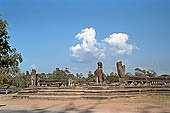
|
From the ticket kiosk your tuk-tuk driver will skirt the south-west corner of the
moat that surrounds the monument and, just at the side of the asphalted road, you will gain the cruciform terrace, embellished with lions, that precedes the
western bridge that crosses the moat.
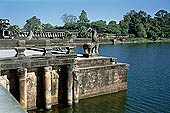
|
Angkor Wat
|
On the other side of the bridge the western entrance of the fourth enclosure is composed by a group of three gopuras with their towers in ruins. The central doorway links the bridge with the causeway to the temple. The two lateral gopuras are also called doors of the elephants.
Inside the central tower there is a restored statue of a four-armed Vishnu (xii c.) (Kuk Ta Reach), perhaps originally put in the tower of the central sanctuary before being destroyed by the Buddhist monks. The eastern façades of the gopuras are decorated with friezes of animals, apsaras and superbly preserved devatas, amongst the finest of the monument. More than 2,000 apsaras, the celestial nymphs who inhabit Indra’s heaven, are carved at Angkor Wat to attend on King Suryavarman II when he went to live in the world of Vishnu.
Angkor Wat |
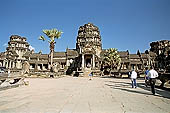
|
From here the 350m long causeway, raised above ground and bordered by naga balustrades, crosses the vast grassy esplanade. Towards the middle and on either side there are the two elegant
libraries just before the pools where the monument reflects itself. The causeway gives way to the cruciform platform with a
naga balustrade and guarding lions preceding the main entrance to the heart of the complex. Before us
is he galleries of the third enclosure: the celebrated gallery of the bas-relief's.
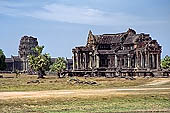
|
Angkor Wat
|
Between the second and the third enclosure there is a crossing cloister formed by three axial galleries, linking the two opposite
gopuras, one transversal gallery and the four basins so formed probably once filled with water. Inside the galleries traces of colourful painting are still visible, and in the tympana motifs from Vaishnavite legends and, on the pillar-base, ascetics in prayer. On one of the axial gallery, the ‘Prah Pean’ (the thousand Buddha's), some statues have been put, though of little interest. In the large surrounding courtyard between the second and the third enclosure there are two ‘libraries’, and false windows decorate the galleries. Steps then lead up to the second gallery and beyond to the heart of the monument.
Angkor Wat |
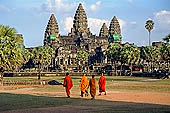
|
The gallery of the second enclosure is decorated with countless devatas , sculpted in bas-relief with an extraordinary variety of intricate hair styles and costumes.
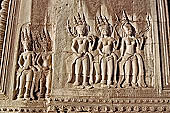
|
Angkor Wat
|
The central group Bakan (the first enclosure) is a 30m high pyramid with 70° slope axial stairways ascending in a single flight of steps to the top where there are the quincunx towers, a representation of Mount Meru. At the time of our visit the central group was closed to visitors.
Angkor Wat |
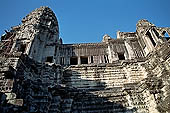
|
The bas-reliefs.
They are described starting from the west entrance following the anticlockwise direction.
West Gallery . Southern Part. The battle of Kurukshetra. We can distinguish musicians, marching warriors and their chiefs carried by elephants or horse drawn chariots. The rubbing by hands of visitors or the remains of some ancient lacquer has given to the
relief's the polished granite appearance.
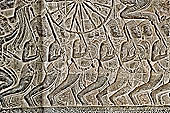
|
Angkor Wat
|
South Gallery . Western Part. The “historical gallery”, dedicated to king Suryavarman II, the builder of Angkor Wat, showing a marching army punctuated by commanders on elephant marked by parasols set against a background of tree foliage, they can be identified by small inscriptions engraved beside them.
Eastern Part. The judgement of the dead by Yama, the supreme judge with multiple arms, mounted on a buffalo, indicates souls to be sent to even or to be thrown down to hell. The unfortunate souls suffer refined cruelties while the elected live in palaces surrounded by their servants, with garudas standing “as atlantes”.
Angkor Wat |
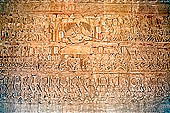
|
East Gallery . Southern Part. The Churning of the Ocean of Milk the grand scene taken from the
Bhagavata Purana. The panel extends for nearly 50m. The highly stylised figures of gods (devas) and demons (asuras) are symmetrically arranged. First we see Ravana, the multi-headed asura, holding the five heads of Vasuki, the giant naga In the centre, on the tortoise Kurma, one of the forms of Vishnu, Vishnu himself represented in human form with Mount Mandara behind him and Vishnu again flying on the top. On the far right finishing the scene we see the great monkey god, Hanuman, holding Vasuki's tail.
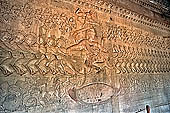
|
Angkor Wat
|
North Gallery . Eastern Part. The Victory of Krishna over Bana. One can identify in a terrific scrum of armies, Krishna mounted on Garuda with eight arms and tiered heads framed by two heroes, Agni, the god of fire, on a rhinoceros. Bana, with multiple arms mounted on a chariot pulled by grimacing lions.
Western Part. The Battle between the gods and the demons. One can recognise: Vishnu with four arms on Garuda, the asura Kalanemi, with four tiered heads, whirling his sword-wielding arms, Brahma on the sacred goose Hamsa, Varuna, the god of the waters, standing on a five headed naga.
Angkor Wat |
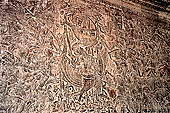
|
West Gallery . Northern Part. The battle of Lanka. Rama standing on Hanuman, next to him his brother Lakshmana and the renegade Vibhisana, the brother of Ravana. On the other side of the panel there is the giant Ravana, with multiple arms and tiered heads, on his war chariot pulled by curiously stylised lions. Between the two, Nila, the furious monkey, straddles two strange lions pulling chariots, presented head-on. A monkey holding two enormous monsters by their rear legs.
North West Corner Pavilion. Surya on his horse drawn chariot, set on his disc.
| |
|
|
 |
|
|



